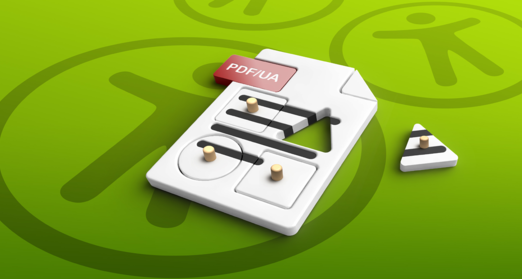
How to Automate the Creation of Accessible PDFs: Challenges and Approaches

How can companies convert their automatically generated documents into accessible PDFs without drastically altering their existing workflows? We have closely examined the topic of automation and accessible PDFs.
Accessible PDFs are not only a legal standard but also an important step towards digital inclusion. However, how can companies that regularly produce large volumes of documents make this process efficient? In this article, we explain how automation and accessible documents can go hand in hand and outline two approaches that companies could use to optimize their workflows without compromising accessibility.
Current Situation
Currently, most PDF documents are not accessible, which excludes a significant number of users from accessing their content. A large portion of these documents is created automatically, such as bank statements or invoices. When we place an order online, the invoice usually lands in our email inbox within a short time. However, it is typically not accessible, as this important aspect was overlooked in the workflow.
"Equal Access" for people with disabilities is not provided here—though it will become mandatory for many companies starting June 28, 2025 (European Accessibility Act and BFSG German Accessibility Strengthening Act)
The Opportunity in Automated Workflows
Automated workflows create a large number of PDF documents in a very short time. All necessary layout information is already available in the system:
- What font is used?
- How is the layout structured?
- How are sections and headings marked?
This layout information can be utilized to create accessible PDFs. The key is translating this into machine-readable information. This allows for the automation of the PDF creation process while ensuring accessibility.

The "Shift Left" Approach: Integrating Accessibility Early in Documents
The "Shift Left" approach plays a pivotal role in the automation of accessible PDFs. This approach aims to integrate accessibility as early as possible in the workflow to avoid later corrections and additional work.
An example of manually implementing accessibility can be found in programs like Microsoft Word or PowerPoint. Here, accessibility can be ensured directly with tools like axesWord or axesSlide. But what about automated workflows where documents are not created manually?
Two Approaches for Automated Accessible PDFs
To generate accessible documents according to PDF/UA standards in automated workflows, there are two main paths:
1. Adjusting and Utilizing Structured Data
Here, data already exists in a structured form in a database but is not yet suitable for direct PDF/UA creation. In this case, the technology used must be able to process this data appropriately and convert it into an accessible format. However, this often requires technical expertise and adjustments to the workflow, which can be very time-consuming in practice.

2. Adjusting Existing PDFs
The second approach utilizes existing layout information from the workflow to configure PDF/UA creation. This occurs as the final step in the process, without the need to modify the existing workflow. The PDF document resulting from the workflow is taken as the source file and enhanced with structural information based on the available layout information to produce an accessible document.
This approach has several advantages:
- Existing workflows remain untouched: No fundamental changes are required; only one step is added at the end.
- Scalability: This method is particularly suitable for large volumes of PDFs, as it is scalable in terms of both the number of PDFs and throughput—how many documents can be created per unit of time.
- Efficiency: The process can be implemented quickly. In the simplest case, implementation may be completed within a week, depending on the duration of the testing phase.

Conclusion: Automated and Efficient Accessible PDFs
Automated solutions for creating accessible PDFs provide companies with the opportunity to organise their workflows efficiently without sacrificing accessibility. With the right approach, existing processes can be expanded without fundamentally changing them.
For companies generating large quantities of documents, this is a crucial step to meeting legal requirements and ensure "Equal Access" for all users.
The deadline for the German Accessibility Strengthening Act “Barrierefreiheitsstärkungsgesetz” on June 28,2025, is approaching, and it is important to take the right measures now to integrate accessible PDFs into the workflow.
Any further questions?
If you would like to upgrade your automated document workflows to include PDF/UA, we would be happy to assist you. A first conversation will help us identify the best starting point together.

